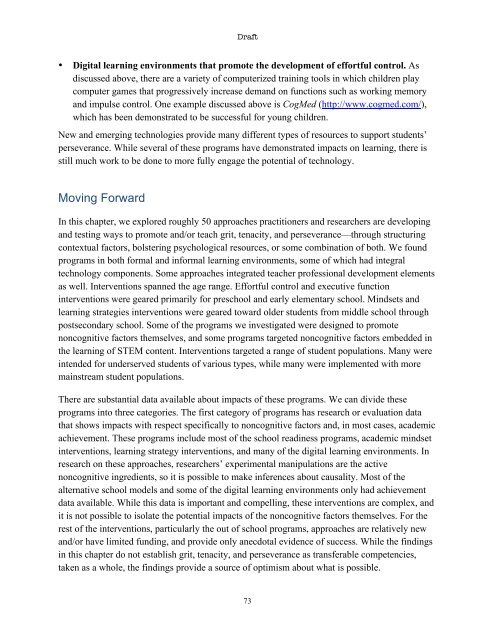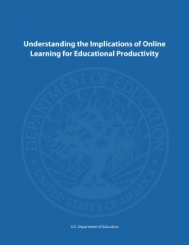Promoting Grit, Tenacity, and Perseverance - U.S. Department of ...
Promoting Grit, Tenacity, and Perseverance - U.S. Department of ...
Promoting Grit, Tenacity, and Perseverance - U.S. Department of ...
You also want an ePaper? Increase the reach of your titles
YUMPU automatically turns print PDFs into web optimized ePapers that Google loves.
Draft<br />
• Digital learning environments that promote the development <strong>of</strong> effortful control. As<br />
discussed above, there are a variety <strong>of</strong> computerized training tools in which children play<br />
computer games that progressively increase dem<strong>and</strong> on functions such as working memory<br />
<strong>and</strong> impulse control. One example discussed above is CogMed (http://www.cogmed.com/),<br />
which has been demonstrated to be successful for young children.<br />
New <strong>and</strong> emerging technologies provide many different types <strong>of</strong> resources to support students’<br />
perseverance. While several <strong>of</strong> these programs have demonstrated impacts on learning, there is<br />
still much work to be done to more fully engage the potential <strong>of</strong> technology.<br />
Moving Forward<br />
In this chapter, we explored roughly 50 approaches practitioners <strong>and</strong> researchers are developing<br />
<strong>and</strong> testing ways to promote <strong>and</strong>/or teach grit, tenacity, <strong>and</strong> perseverance—through structuring<br />
contextual factors, bolstering psychological resources, or some combination <strong>of</strong> both. We found<br />
programs in both formal <strong>and</strong> informal learning environments, some <strong>of</strong> which had integral<br />
technology components. Some approaches integrated teacher pr<strong>of</strong>essional development elements<br />
as well. Interventions spanned the age range. Effortful control <strong>and</strong> executive function<br />
interventions were geared primarily for preschool <strong>and</strong> early elementary school. Mindsets <strong>and</strong><br />
learning strategies interventions were geared toward older students from middle school through<br />
postsecondary school. Some <strong>of</strong> the programs we investigated were designed to promote<br />
noncognitive factors themselves, <strong>and</strong> some programs targeted noncognitive factors embedded in<br />
the learning <strong>of</strong> STEM content. Interventions targeted a range <strong>of</strong> student populations. Many were<br />
intended for underserved students <strong>of</strong> various types, while many were implemented with more<br />
mainstream student populations.<br />
There are substantial data available about impacts <strong>of</strong> these programs. We can divide these<br />
programs into three categories. The first category <strong>of</strong> programs has research or evaluation data<br />
that shows impacts with respect specifically to noncognitive factors <strong>and</strong>, in most cases, academic<br />
achievement. These programs include most <strong>of</strong> the school readiness programs, academic mindset<br />
interventions, learning strategy interventions, <strong>and</strong> many <strong>of</strong> the digital learning environments. In<br />
research on these approaches, researchers’ experimental manipulations are the active<br />
noncognitive ingredients, so it is possible to make inferences about causality. Most <strong>of</strong> the<br />
alternative school models <strong>and</strong> some <strong>of</strong> the digital learning environments only had achievement<br />
data available. While this data is important <strong>and</strong> compelling, these interventions are complex, <strong>and</strong><br />
it is not possible to isolate the potential impacts <strong>of</strong> the noncognitive factors themselves. For the<br />
rest <strong>of</strong> the interventions, particularly the out <strong>of</strong> school programs, approaches are relatively new<br />
<strong>and</strong>/or have limited funding, <strong>and</strong> provide only anecdotal evidence <strong>of</strong> success. While the findings<br />
in this chapter do not establish grit, tenacity, <strong>and</strong> perseverance as transferable competencies,<br />
taken as a whole, the findings provide a source <strong>of</strong> optimism about what is possible.<br />
73
















